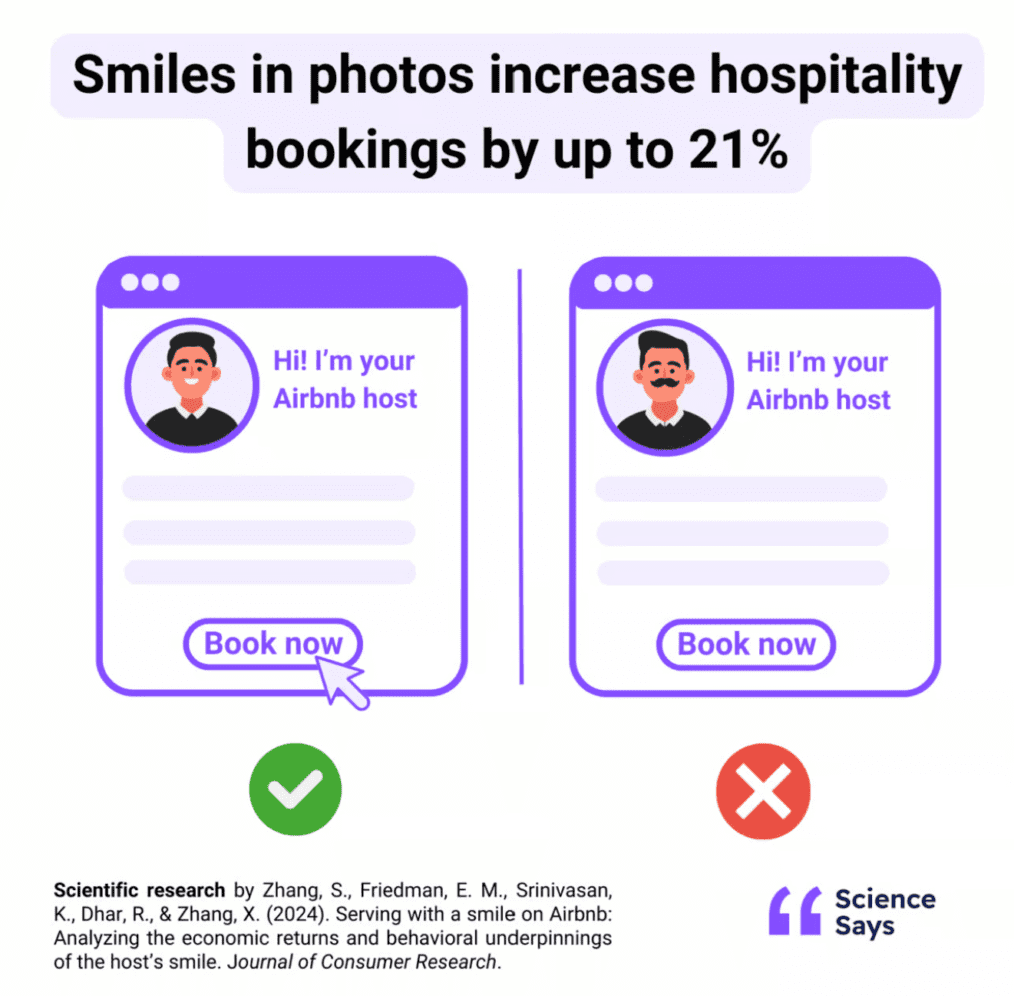Smiling photos (vs. not smiling) service providers are reassuring and increase hospitality bookings (e.g. hotels, Airbnb) by up to 21%.
You’re setting up a website for a family boutique hotel. You’ve listed descriptions, and reviews and would like to include a picture of the owner, Matt, too. Yet you find yourself unsure which one to go for:
- One with a friendly smile – you feel it seems more welcoming
- One with a serious, contemplative face – you feel it might seem more professional and trustworthy
Will it even change how likely people are to book Matt’s place? Science says it makes a big difference.
Note: Other research finds a big difference in the type of smile you show. Use either a big smile or a slight smile depending on your goals.
Smiling in profile photos increases hospitality service bookings
Topics: Ecommerce | Website/App | Ads
For: B2C. Can be tested for B2B.
Research date: August 2024
Universities: Harvard Business School. Columbia University. Carnegie Mellon University. Yale University. East China Normal University.
Recommendation: If you provide or advertise a hospitality service (e.g. Airbnb, hotel), show pictures of smiling hosts – especially if the host is a male. People will be more likely to trust you and book.
The effect is likely to extend to other contexts where a personal connection is important (e.g. coaching), although this was not directly tested.


Findings
- People prefer hospitality service providers who smile in their photos. People find them more likable and trustworthy and are more likely to book their services or listings.
- In a series of 4 experiments and observations from 9,248 Airbnb hosts, researchers compared smiling photos to non-smiling photos and found that people:
- Rated smiling hosts as 16% more competent, and 44% warmer and more trustworthy
- Felt 24% more comfortable interacting with (e.g. sending a message) smiling hosts
- Were up to 8% more likely to book smiling hosts’ Airbnbs
- Were 21% more likely to book hotels, both large chain (e.g. Hilton) and family-owned (e.g. local boutique hotel)
- The smiling effect:
- Is stronger when customers feel uncertain about the service (e.g. the hotel has just opened and has few reviews)
- Is very small for female hosts, since people already perceive them as more warm and reassuring than male hosts
Why it works
- When booking a stranger’s service, we don’t know what we’ll get or what the service provider will be like.
- So we look for hints and clues that can reduce our uncertainty.
- Seeing a photo of a smiling service provider makes us think they are warm and competent.
- This reduces anxiety by making the experience feel more predictable and comfortable.
- This is called a “halo effect”: one positive trait (a smile) reflects on other traits (the listing) and increases our overall trust.
- Male hosts can benefit more from smiling than female hosts because men are generally perceived as less warm, making customers more uncertain about their style of interactions or hosting.
New industry research from TikTok and Tracksuit, a global brand tracking company, shows just how powerful performance and brand marketing are when they work together.
For example, high brand awareness advertisers drive 2.86x more lower-funnel conversions (e.g. purchases) vs low awareness advertisers.
Limitations
- The authors focused on hospitality only (Airbnb, family-owned, and larger brand hotels). There may be differences for other industries (e.g. beauty, healthcare, leisure), although the effect is likely similar for services where personal connection (e.g. a massage, a coaching session) is important.
- The research did not differentiate between pictures of genuine and forced smiles. A smile that seems genuine rather than fake might create more trust.
- The study only analyzed profile images that showed one person – the main service provider (e.g., the Airbnb host or a manager of a hotel). It did not consider showing multiple, other people (e.g. team members).
Companies using this
- 75% of Airbnb hosts in the US use a smiling photo (based on 9,248 hosts in this study).
- Hotels tend to show pictures of their general managers or group team pictures of smiling, welcoming staff.
- Across other industries (e.g. wellness, ecommerce, Saas, marketing services) photos tend to feature leadership, founders, and providers and show them smiling as well.
- Smiling photos are usually placed on the “About Us”, and “Contact Us” pages or next to CTA’s:
Steps to implement
- For hospitality and service listings, or in their advertising, choose photos in which people are smiling, especially if:
- The person in the picture is a man
- The goal of the picture is to assure and create a sense of trust
- Place these photos where people expect to learn about the business or service (e.g., “About Us” pages) or where you seek to encourage interaction (e.g., contact pages, CTAs, booking page).
- Adjust the type of the smile according to the service type and your customers’ cultural preferences:
- If the capability is relevant (e.g. law, medicine), use a milder smile to look more confident.
- If warmth is more important (e.g. event host), use a wider smile to look friendlier
- For individualistic cultures (e.g. US, Canada, and Australia) go for wider, more excited smiles.
- Opt for a calmer smile for collectivist cultures (e.g. China, Japan, Korea)
Related:
Musk: Tesla to build 5,000 Optimus robots in 2025, tells staff not to sell shares
Trump Promises ‘Flexibility’ on Reciprocal Tariffs
Trump Promises ‘Flexibility’ on Reciprocal Tariffs
MicroCloud Hologram Reports Strong 2024 Financial Results, Eyes Global Expansion
Dollar Role in Global Economy: Analyzing US dollar future’s reserve currency status
Collapse of Enron (2001) – How corporate fraud reshaped corporate governance










